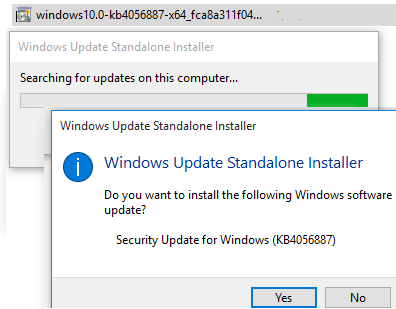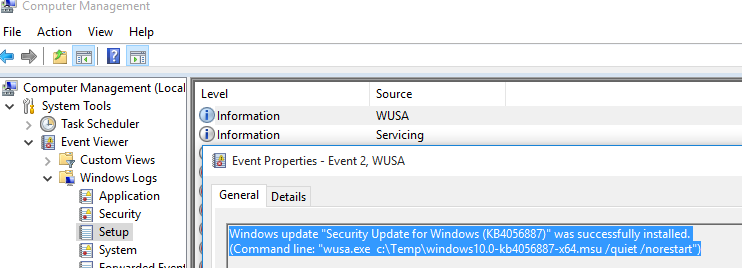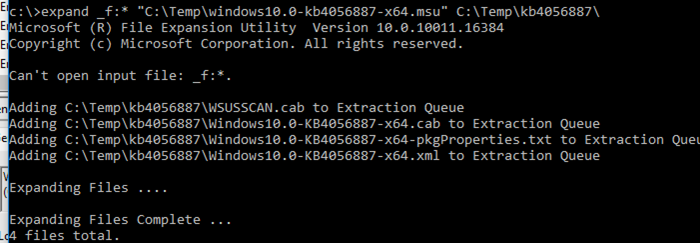How To Install Microsoft Update Standalone Package
Windows updates are released as packages with the MSU or CAB extensions. If Windows Update service is not working (or specifically disabled), you can manually download and install the necessary cumulative or security updates for your system. In this article we'll show how to download and offline install updates in the MSU or CAB file formats in Windows 10.
Contents:
- How to Manually Download the MSU Windows Update File
- Installing MSU Update File in Windows
- How to Extract a CAB File from an MSU Update Parcel
- Installing a CAB Update File in Windows 10
How to Manually Download the MSU Windows Update File
Initially, Microsoft released security updates and patches in the CAB (Windows cabinet) file format. This is how your computer receives updates from Microsoft update servers or a local WSUS server. To make manual distribution of separate updates using Microsoft Update Catalog more convenient, these CAB files are packed in a special MSU format (Microsoft Update Standalone Installer Packet).
You lot can download MSU Windows updates files (sometimes as well CAB files) or files for other Microsoft products from Microsoft Update Catalog (https://www.catalog.update.microsoft.com/). Become to Microsoft Update Catalog, find and download the update yous need. For instance, I want to install an Adobe Flash Player security update for Windows 10 x64 1507 – KB4056887. Click Download.

Movement the file windows10.0-kb4056887-x64_fca8a311f0495e669715ae5aa0e0d8720f945049.msu you have downloaded to the C:\temp folder. Rename it, to get a shorter name: windows10.0-kb4056887-x64.msu
Installing MSU Update File in Windows
To start the installation of a Windows update package, just double-click the MSU file you take downloaded. If the update is applicative to this computer, a Windows Update Standalone Installer window will open up, where you will be prompted to ostend the update installation.

Yous tin as well install an MSU update packet using wusa.exe in the command prompt.
To install the update in a silent mode (a user won't see whatsoever pop-up windows) with a later restart, open the command prompt as ambassador and run the post-obit control:
wusa.exe c:\Temp\windows10.0-kb4056887-x64.msu /quiet /norestart

In some fourth dimension make sure that the update has been installed successfully by running this control:
wmic qfe list | findstr 4056887

Or in the Setup effect log, find an entry with the Event ID two from the source WUSA and the following message:
Windows update "Security Update for Windows (KB4056887)" was successfully installed. (Command line: "wusa.exe c:\Temp\windows10.0-kb4056887-x64.msu /tranquillity /norestart")

Please note that the installation of updates in MSU format in Windows via wusa.exe is slower than when installing the same update as CAB file. The reason is the execution of additional processing with scanning on WU / WSUS servers.
How to Extract a CAB File from an MSU Update Package
In some cases when Windows Update that is used by wusa works incorrectly (try to reset Windows Update agent settings start), y'all can't install an update in the MSU format. In this case you can unpack MSU package manually, excerpt a CAB file from information technology and install it manually in your arrangement.
To unpack an MSU package to C:\Temp\kb4056887 (you have to create this folder in advance), run this command:
aggrandize _f:* "C:\Temp\windows10.0-kb4056887-x64.msu" C:\Temp\kb4056887

Microsoft (R) File Expansion Utility Version 10.0.10011.16384
Copyright (c) Microsoft Corporation. All rights reserved.
Adding C:\Tmp\kb4056887\WSUSSCAN.cab to Extraction Queue
Adding C:\Tmp\kb4056887\Windows10.0-KB4056887-x64.cab to Extraction Queue
Calculation C:\Tmp\kb4056887\Windows10.0-KB4056887-x64-pkgProperties.txt to Extraction Queue
Adding C:\Tmp\kb4056887\Windows10.0-KB4056887-x64.xml to Extraction Queue
Expanding Files ….
Expanding Files Complete …
4 files total.
As yous can encounter, 4 file types have appeared in the folder:
- An .xml file (Windows10.0-KB4056887-x64.xml) that contains MSU package metadata and used by wusa.exe;
- A .cab file (Windows10.0-KB4056887-x64.cab — i or more) is an archive with Windows update;
- *pkgProperties.txt file (Windows10.0-KB4056887-x64-pkgProperties.txt) that contains package properties (release date, architecture, packet blazon, a link to the KB, etc.).
Installing a CAB Update File in Windows 10
You can install a CAB update file obtained from an MSU packet in two means.
The nearly common way to install an update from a CAB file is using DISM.exe. The installation command can look like this:
DISM.exe /Online /Add-Package /PackagePath:c:\Temp\kb4056887\Windows10.0-KB4056887-x64.cab
Deployment Epitome Servicing and Management tool
Version: 10.0.10240.16384
Image Version: 10.0.10240.16384
Processing one of ane — Calculation package Package_for_KB4056887~31bf3856ad364e35~amd64~~10.0.1.0
[==========================100.0%==========================]
The operation completed successfully.

Note. Please note that the installation of a package using DISM goes faster compared to the installation of the update from an MSU file using wusa.exe.
If you lot accept to install a CAB bundle in a silent style with a later restart, utilise the following DISM command:
beginning /expect DISM.exe /Online /Add-Package /PackagePath: c:\Temp\kb4056887\Windows10.0-KB4056887-x64.cab /Placidity /NoRestart
In Windows 8 and Windows seven, you can install an update using Pkgmgr. The command is:
starting time /w Pkgmgr /ip /one thousand:c:"c:\Temp\kb4056887\Windows10.0-KB4056887-x64.cab"
Annotation. The PkgMgr.exe package manager is no longer supported in Windows ten / Windows Server 2022. When you run information technology, you lot receive a warning that you need to use DISM.exe to manage the packages.
Annotation: The PkgMgr.exe has been deprecated. Please update your scripts to use dism.exe to extract, install, uninstall, configure and update features and packages for Windows.

Notation. Please note that Windows linguistic communication packs (MUI) are also distributed in CAB format. However, you won't exist able to apply a DISM control to install them. You will have to utilize a separate tool, lpksetup.exe, to install new languages in your system instead.
This guide on manual installation of cumulative or any other Windows updates is applicative to all supported Windows OS versions: Windows ten / 8.1 / 7 and Windows Server 2022 / 2022 / R2 / 2008 / R2.
Source: http://woshub.com/manually-install-cab-msu-updates-windows/#:~:text=To%20start%20the%20installation%20of,to%20confirm%20the%20update%20installation.
Posted by: munozmame1952.blogspot.com


0 Response to "How To Install Microsoft Update Standalone Package"
Post a Comment